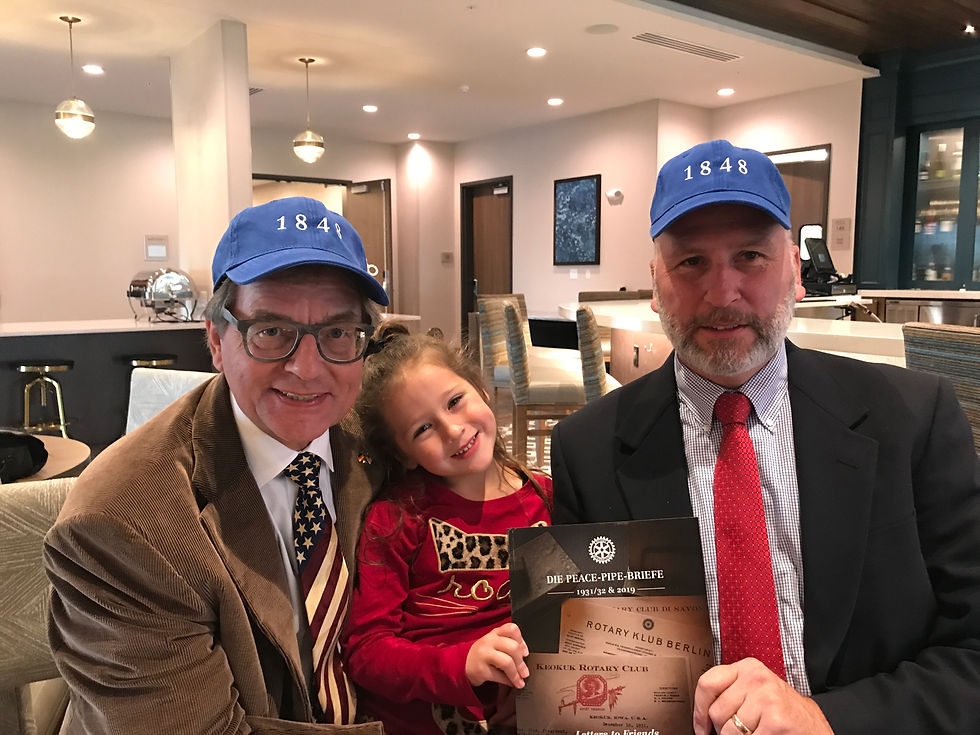Rotary and its Enthusiasm for Peace: www.KeokukPeaceLetters.com
- Joachim Reppmann
- Oct 5, 2020
- 4 min read
Originally Published by Germanic ROTARY MAGAZIN, Hamburg – September 2020
In 1931, American Rotarians sought to send a symbol of peace in uncertain times around the world. This ultimately led eighty-nine years later to an international project. // Matthias Schütt
www.Peace-Pipe-Proposal.com

The publishers Joachim Reppmann (left) Ivy and Tony Conn holding their book.
Keokuk—the Indian name of this small town, located on the Mississippi River in the state of Iowa, might have been enough in itself to arouse interest among Rotarians when they received a letter from this address. But the content of the letter made them really take notice. The Rotary Club of Keokuk, named after a famous chieftain of the Sauk and Fox tribes, was inviting its Rotary friends beyond the seas to smoke the peace pipe with them. In Germany, this must have immediately reminded many recipients of books by Karl May and James Fenimore Cooper; this is apparent at any rate in several of the return letters send by German clubs.
But the letter from the United States had a serious purpose. In 1931 the world was on the brink of disaster. The consequences of the world financial crisis and the advance of National Socialism was frightening to Rotarians, and not only those in Europe. One of these was the businessman William Jewett Fulton from Keokuk, who had just spent the summer in Europe in order to attend the Rotary International Convention in Vienna. Outside of the safe world of Rotary, the approaching menace was already perceptible, which is why, once back in Iowa, Fulton suggested to his fellow Club members that they write to all 504 Rotary Clubs outside of the United States to express their common sense of good will and to affirm the ideal of understanding among peoples.
A chieftain as a messenger of peace
In this letter Fulton chose the symbol of the peace pipe, because the town’s namesake, Chief Keokuk (ca. 1780-1848), had gone down in history as a conciliatory treaty partner of the white conquerors. Even though the American authorities had broken treaties with the indigenous tribes again and again and constricted their living space through land acquisitions, Keokuk saw no alternative but to conduct negotiations. What he had witnessed was a gruesome shedding of blood that had to be stopped.
For Fulton and his Club friends the peace pipe was “the greatest gesture of hospitality”—one they wanted to share with all their friends worldwide. “We would be happy,” Fulton wrote, “if we received an answer from you, for it is our serious hope to promote contact and friendship with Rotarians beyond our borders.” To give an idea of the dimensions of their project, long before the days of “copy and paste”: each of the 504 letters was personally addressed and individually typed.
Cigars as a substitute
Two hundred and one clubs, somewhat less than half, responded to the request. Of the twenty-six German clubs, fifteen wrote back. In Aachen, the letter was read “at the moment in which we lit our cigars after our meal, so that we honored your kind invitation in spirit.” While some of the clubs pointed to the “truly extraordinarily difficult position of our fatherland,” others emphasized “the great moral seriousness” with which Rotary was pursued in Germany.
This is actually where the story ends, yet it had three consequences that extend into the present day. Decades passed by without anyone in Keokuk remembering the letters—until they resurfaced one day in a bank safe. This gave Tony Conn, the president of the local Club, the idea of combining the letters of response in book form in time for the Rotary International Convention in Hamburg, and to write to the German Clubs again, expressing the view that the world was in a similarly critical position concerning understanding among peoples. Tony Conn of Keokuk unfortunately received only one response in 2019; the remaining fourteen German Rotary Clubs contacted by Rotarian Fulton in 1931 did not write back.
The book was published by Conn and the historian Joachim Reppmann from Flensburg, who has lived in the United States for years, has taught as a professor in Minnesota, and is a member of the Rotary Club of Northfield, Minnesota. During the Hamburg Convention he organized a meeting using the symbol of the peace pipe and issued an invitation for a bus trip with “book party” to the Flensburg Fjord. The participants included 135 members from 68 peace pipe clubs in 21 countries.

A peace project for Africa
The second consequence is the forthcoming establishment of a Rotaract “Peace Pipe E-Club” in District 5950 of the United States. And the third is a current Project in Africa. On the initiative of South Africa, one hundred mediators have recently been in training; their purpose will be to settle social conflicts at a sub-judicial level. The project countries are Angola, Botswana, Eswatini (Swaziland), Lesotho, Mozambique, Namibia, and South Africa. The emphasis is on helping disadvantaged groups in particular, such as women and young people. The idea is to expand the model to as great an extent as possible to all African countries.





Comments